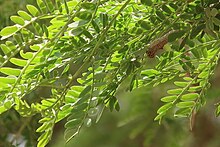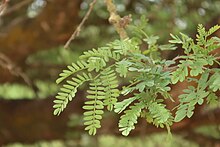| Faidherbia | |
|---|---|

| |
| F. albida in the Elah valley, Israel | |
| Scientific classification | |
| Kingdom: | Plantae |
| Clade: | Tracheophytes |
| Clade: | Angiosperms |
| Clade: | Eudicots |
| Clade: | Rosids |
| Order: | Fabales |
| Family: | Fabaceae |
| Subfamily: | Caesalpinioideae |
| Clade: | Mimosoid clade |
| Genus: | Faidherbia A.Chev. |
| Species: | F. albida |
| Binomial name | |
| Faidherbia albida (Delile) A.Chev. | |

| |
| range of F. albida | |
| Synonyms | |
| |

 Inflorescences (MHNT) and dry seed pods, the latter resembling apple rings
Inflorescences (MHNT) and dry seed pods, the latter resembling apple rings
Faidherbia is a genus of leguminous plants containing one species, Faidherbia albida, which was formerly widely included in the genus Acacia as Acacia albida. The species is native to Africa and the Middle East and has also been introduced to Pakistan and India. Common names include apple-ring acacia (their circular, indehiscent seed pods resemble apple rings), white acacia, and winter thorn. The South African name is ana tree.
Taxonomy
This species has been known as Acacia albida for a long time, and is often still known as such. Guinet (1969) in Pondicherry first proposed separating it into the genus Faidherbia, a genus erected during the previous century by Auguste Chevalier with this as the type species, seconded by the South African James Henderson Ross (1973) and the Senegalese legume botanist Nongonierma (1976, 1978), but authors continued to favour classification under Acacia as of 1997.
Infraspecific variability
According to John Patrick Micklethwait Brenan, as written in the Flora of Tropical East Africa (1959), two forms can be distinguished in this region (Kenya, Tanzania, Uganda). Race A is distinguished by generally smooth features, whereas race B is more hairy. Ross (1979) notes that all trees in the south of central Tanzania belong to race B. Similarly, Nongonierma described two variants for Senegal, var. glabra and var. pseudoglabra, but his distinction was disregarded taxonomically as of 2007.
Description
Faidherbia is a thorny tree growing up to 6–30 m (20–98 ft) tall and up to 2 m (6+1⁄2 ft) in trunk diameter. Its deep-penetrating tap root makes it highly resistant to drought. The bark is grey, and fissured when old. There are 11,000 seeds/kg.
Distribution
In Southern Africa, it is absent from most of the territory, avoiding dry, colder and upland areas or areas of winter rainfall, but it does occur in the eastern Caprivi Strip, the northern Okavango basin, the floodplains of the Linyanti, Zambezi and Limpopo rivers, as well as southwards to Gaborone. In Zimbabwe, the tree is absent from the highlands and central plateau, but it does occur in Gonarezhou and southwards to the Kruger Park and adjacent lowveld of western Gaza and southern Maputo provinces. It reaches its southern limit along the Pongola floodplain in Maputaland. In western Namibia, it is present in the Kaokoveld, Damaraland, and the Namib-Naukluft area.
In the rest of Africa, it is absent from deserts, areas of high rainfall, tropical rainforests and mountainous areas, but occurs throughout the eastern half of the continent from the southern coast in Maputaland to Egypt, throughout the Subsaharan Sahel and the Horn of Africa. In Northern Africa, besides in Egypt it also occurs in Algeria, it does not occur in Morocco proper, but is found in Western Sahara.
In Asia, it is thought to be native to Yemen and Saudi Arabia in the Arabian Peninsula, Iran, and in the Levant in Israel, Syria and Lebanon. In Israel, the tree is protected by law.
A population is found in relict groves in Israel (in the Shimron nature reserve, near the community settlement of Timrat, and in the western-most reaches of the Valley of Elah). All of the trees in a given grove are genetically identical and seem to have multiplied by vegetative reproduction only, for thousands of years.
Introduced populations are found in Cyprus, Pakistan, and India (Karnataka), as well as on Ascension Island.
Ecology
In Southern Africa, it usually grows on alluvial floodplains in bushveld, on riverbanks or flood pans, in swamps, or in dry watercourses that can flood during rains. It grows in woodland in the Sahel, along the Zambezi, and in Sudan. In the Sahel, it grows gregariously in groves. It also grows in savannahs in Sudan and the Sahel, in heavy soils with good drainage.
In tropical eastern Africa, it sometimes occurs singly, but may often be the dominant species in dry woodlands. In the Sahel, it has an irregular, clumped distribution, absent in some areas, but occurring in others.
It grows in areas with 250–600 mm (10–23+1⁄2 in) of rain per year.
Uses
Faidherbia albida is important in the Sahel for raising bees, since its flowers provide bee forage at the close of the rainy season, when most other local plants do not.

The seed pods are used for raising livestock, are used as camel fodder in Nigeria, and are eaten by stock and game in Southern Africa. They are relished by elephant, antelope, buffalo, baboons and various browsers and grazers, though strangely ignored by warthogs and zebras.
The wood is used for canoes, mortars and pestles, while the bark is pounded in Nigeria and used as a packing material on pack animals. The wood has a density of about 560 kg/m at a water content of 12%. The energy value of the wood as fuel is 19.741 kJ/kg.
Ashes of the wood are used in making soap and as a depilatory and tanning agent for hides. The wood is used for carving and the thorny branches useful for a natural barbed fence. Pods and foliage are highly regarded as livestock fodder. Some 90% of Senegalese farmers interviewed by Felker (1981) collected, stored, and rationed Acacia albida pods to livestock. Zimbabweans use the pods to sedate fish. Humans eat the boiled seeds in times of food scarcity in Zimbabwe.
It is valued in agroforestry as it fixes nitrogen shortages, and a high yield has been achieved in at least one test plot of maize crops grown amongst the trees at a density of 100 to 25 tree per hectare. According to a 2018 article in The Guardian, monocultures of this species are popular in parts of Niger, where it is known as gao in Hausa, to use for intercropping.

It is also used for erosion control. Its value as an agroforestry tree lies partially in the fact that the tree drops its leaves during the rainy season, and therefore does not compete with crops for sunlight. The trees' use in farmer-managed natural regeneration of degraded soils throughout southern Niger since the 1990s has been described by one writer as "the biggest positive environmental transformation in the Sahel, and possibly in Africa".
Medicinal uses
An extract is used to treat ocular infections in farm animals. The bark is used in traditional medicine in Southern Africa, and Niger.
Cultural significance

Faidherbia albida is known in the Bambara language as balanzan, and is the official tree of the city of Segou on the Niger River in central Mali. According to legend, Segou is home to 4,444 balanzan trees, plus one mysterious "missing tree" – the location of which cannot be identified.
In Serer and some of the Cangin languages, it is called Saas. Saas figures prominently in the creation myth of the Serer people. According to the myth, it is the tree of life and fertility.
References
- ^ African Plants Database: Faidherbia albida Archived 2007-09-26 at the Wayback Machine
- ^ ILDIS LegumeWeb
- C.Michael Hogan, ed. 2010. Faidherbia albida. Encyclopedia of Life.
- Armstrong, W. P. "Unforgettable Acacias, A Large Genus Of Trees & Shrubs". Wayne's Word. Archived from the original on 10 November 2015. Retrieved 17 November 2015.
- ^ Shmida, Avi (2005). MAPA's Dictionary of Plants and Flowers in Israel (in Hebrew). Tel-Aviv: MAPA Publishers. p. 260. OCLC 716569354.
- ^ van Wyk, Braam; van Wyk, Piet (1997). Field Guide to trees of southern Africa. Cape Town: Struik. p. 500. ISBN 1-86825-922-6.
- ^ Geerling, Chris (15 July 1982). "Guide de terrain des ligneux Saheliens et Soudano Guineens". Mededelingen Landbouwhogeschool Wageningen (in French). 82 (3): 177, 178.
- ^ FAO: Handbook on Seeds of Dry-Zone Acacias
- Cunliffe, Rob; Muller, Tom; Mapaura, Anthony (August 2012). "Vegetation survey of Gonarezhou National Park, Zimbabwe (Final report)" (PDF). gonarezhou.org. Frankfurt Zoological Society et al. Retrieved 6 April 2023.
- ^ World AgroForestry
- Kevin M. Dunham (1990). "Fruit production by Acacia albida trees in Zambezi riverine woodlands". Journal of Tropical Ecology. 6 (4): 445–457. doi:10.1017/S0266467400004843. S2CID 85090695.
- FAO: Role of acacia species in the rural economy of dry Africa and the Near East
- VITA (1977)
- Bayala, Jules; Larwanou, Mahamane; Kalinganire, Antoine; Mowo, Jeremias G.; Weldesemayat, Sileshi G.; Ajayi, Oluyede C.; Akinnifesi, Festus K.; Garrity, Dennis Philip (2010-09-01). "Evergreen Agriculture: a robust approach to sustainable food security in Africa" (PDF). Food Security. 2 (3): 197–214. doi:10.1007/s12571-010-0070-7. ISSN 1876-4525. S2CID 12815631. Archived from the original (PDF) on 2012-10-21. Retrieved 2016-03-02.
- ^ MacLean, Ruth (2018-08-16). "The great African regreening: Millions of 'magical' new trees bring renewal". The Guardian.
- Becking, David. "Faidherbia albida". Trees SA. Retrieved 24 December 2020.
- Villalón, Leonardo, ed. (2021). "Chapter 11: Land Use Change and Climate-Smart Agriculture in the Sahel". The Oxford Handbook of the African Sahel. Oxford University Press. pp. 209–230. ISBN 9780198816959.
- BBC News story on Mali's Faidherbia albida trees
- (in French) Gravrand, Henry, "La civilisation sereer", vol. II : Pangool, Nouvelles éditions africaines, Dakar, 1990, pp. 125–127, ISBN 2-7236-1055-1
Further reading
- Edmund G.C.Barrow. 1996. The Drylands of Africa:Local Participation in Tree Management. Initiatives Publishers: Nairobi, Kenya.
- A.E.G.Storrs. 1979. Know Your Trees: Some Common Trees Found in Zambia. Government Republic of Zambia, Forestry Department: Ndola, Zambia.
- Africa: Forestry, Agroforestry and Environment
- Hawaiian Ecosystems at Risk project (HEAR)
- Purdue University New Crop Resource Online Program
External links
 Data related to Faidherbia albida at Wikispecies
Data related to Faidherbia albida at Wikispecies Media related to Faidherbia albida at Wikimedia Commons
Media related to Faidherbia albida at Wikimedia Commons- Faidherbia albida in West African plants – A Photo Guide.
- "Faidherbia albida". PlantZAfrica.com. Archived from the original on 2008-01-17. Retrieved 2010-02-09.
- Faidherbia albida
| Taxon identifiers | |
|---|---|
| Faidherbia | |
| Faidherbia albida |
|